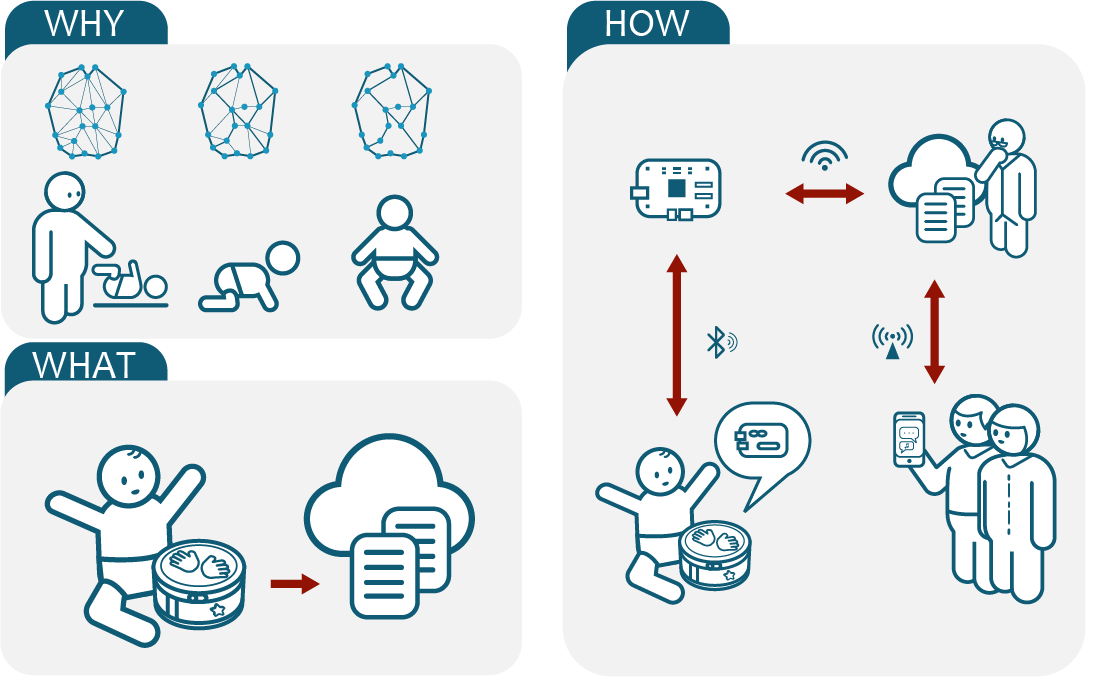Development of smart toys for studying the sensorimotor function of children


Background: The revolution in Artificial intelligence has resulted, within the past five years, in super human solution of many problems, such as object recognition and Go play. These deep neural network models require more than an order of magnitude more energy and data for training compared to the human brain. Humans can in many cases even learn from a single example. New insights into how humans learn could help us develop more efficient algorithms for training artificial neural networks. Advances in sensors and Internet of Things technology has made it possible to build smart toys for data recoding during experiments and a number of such studies have been published. The sensorimotor function develops early in infants and it can be quantified using sensors embedded in toys. To understand the development of children, longitudinal studies are needed. However, most longitudinal studies are focused on language development.
Aim: We aimed to provide new insights into the development and learning of infants. We believe that new insights could be gained through long-term longitudinal studies with daily quantification of the perception and motor skills during normal play with toys. Towards this aim we here present the development of two prototype toys for data collection from infants.
Method: Our smart drum and bongo are commercial toys updated with embedded electronics for data recording, Internet access, and two-way communication through the chat App Telegram. Our smart pacifier is a Philips Soothie pacifier updated with an inertial measurement unit (IMU) with Bluetooth for tracking of movement in real-time. We implemented and evaluated an inertial navigation system (INS) in the smart pacifier to estimate the trajectory of movement.
Results: We built, demonstrated, and tested the smart bongo/drum and smart pacifier. Our chatbot translates each press of a button to an image sent to the Telegram chat App of any authorized subscriber and commands given by the subscriber into light stimuli in the drum/bongo. We implemented a Madgwick filter and an Unscented Kalman filter in the smart pacifier as the INS for tracking of relative position. The error of the trajectory estimation from smart pacifier is too large for the position estimates to be of use, but the trajectory can be used to recognize the pattern of the movement.
Conclusion: We report on the design and first field tests. These tools show potential for long-term longitudinal data collection in the home of children, but challenges with reliability and battery life remain.
Keywords: Smart toy, Internet of toys, sensorimotor function, chatbot, Madgwick filter, Unscented Kalman filter.
用於研究兒童感知運動功能之智慧玩具開發
研究背景: 在過去的五年裡,人工智慧的發展已經用來作為解決許多複雜問題的方案,例如物體識別和圍棋。然而與人類大腦相比,這些深度神經網路模型需要的訓練量和數據遠遠要多一個數量級。在許多情況下,人類甚至可以從一個例子中學習。洞悉人類的學習方式可以幫助我們開發更有效的算法來訓練人工神經網路。傳感器和物聯網技術的進步使得在實驗期間構建用於數據重新編碼的智能玩具成為可能,並且已有許多相關發表的研究。感覺運動功能在嬰兒早期發展,可以使用嵌入玩具中的傳感器進行量化。要了解兒童的發展,需要進行縱向的研究。然而,大多數縱向研究都集中在語言發展上。
研究目標: 我們的目標是為嬰兒的發展和學習提供新的見解。我們相信,通過長期縱向研究,量化每天正常玩耍玩具時的感知和運動技能可以獲得新的見解。為實現這一目標,我們在此展示了兩種用於嬰兒數據採集之原型玩具之開發。
研究方法: 我們的智能鼓和智能邦哥鼓原是商業玩具,安裝了嵌入式電子設備,用於數據記錄,互聯網訪問和通過聊天App Telegram的雙向通信。我們的智能安撫奶嘴是一款飛利浦Soothie安撫奶嘴,配有帶藍牙的慣性測量感測器(IMU),可實時跟踪運動。我們在智能安撫奶嘴中實施並評估了慣性導航系統(INS),以估計運動軌跡。
研究結果: 我們製造,展示和測試了智能小鼓/邦哥鼓和智能安撫奶嘴。我們的聊天機器人將每次按下按鈕轉換為圖像並發送到任何授權用戶的聊天室,以及訂閱戶可以給予鼓/邦哥鼓中的光刺激的命令。我們在智能奶嘴中實施了Madgwick過濾器和無損卡爾曼濾波器作為用於跟踪相對位置的慣性導航系統。智能安撫奶嘴的軌跡估計誤差對於我們要求的微小運動來說太大,但是軌跡還是可以用於識別運動模式。
研究結論: 我們報告智能玩具之設計和首次現場測試。這些工具顯示了在兒童家中長期縱向數據採集的潛力,但仍存在可靠度和電池壽命方面的挑戰。
關鍵字: 智慧玩具, 物聯網玩具, 感覺動作功能, Madgwick濾波, 無損卡爾曼濾波

Principal Investigator: Ass. Prof. Torbjörn Nordling
Collaborator: Asc. Prof. Yun-Hsuan Chang, Asia University
Members: Alan Yu, Butters Wu, Shun-Jie Zhang, Bart van Bueren, Akram Ashyani, Torbjörn Nordling
